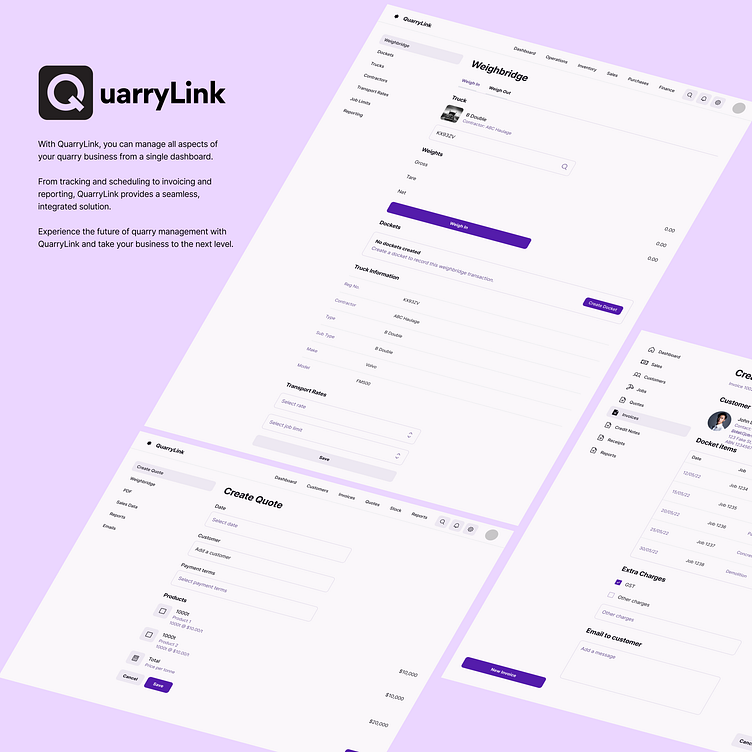QuarrLink CRM / Weigh Bridge
Case Study: QuarrLink CRM Weigh Bridge
The QuarrLink CRM Weigh Bridge project was aimed at developing a specialized customer relationship management (CRM) system integrated with weighbridge functionalities. This platform was designed to streamline the operations of quarry businesses, providing a comprehensive solution for managing customer interactions, tracking orders, and monitoring material weights. The key objective was to create an efficient, user-friendly interface that would simplify complex processes and enhance operational efficiency.
Challenge
The primary challenge was to integrate CRM capabilities with real-time weighbridge data, ensuring accuracy and ease of use. The system needed to cater to different user roles, including administrators, operators, and customers, each requiring tailored access to specific functionalities. Additionally, the design had to accommodate a vast amount of data, including customer details, order histories, and weight measurements, while maintaining clarity and usability.
Design Process
1. Discovery and Research
To kick off the project, in-depth research was conducted to understand the specific needs of quarry businesses. This involved interviews with key stakeholders, including quarry managers, operators, and sales teams. The insights gained helped in identifying the core functionalities required and the pain points that needed addressing.
2. Persona Creation and User Journey Mapping
Based on the research, personas representing the different user roles were created. User journeys were mapped out to visualize how each persona would interact with the system, highlighting their needs and expectations at various touchpoints.
3. Wireframing and Prototyping
Initial wireframes were developed to outline the structure and flow of the application. These wireframes focused on the key components, such as the dashboard, weighbridge integration, order management, and customer interaction modules. Interactive prototypes were then created using Figma, allowing for early usability testing and feedback collection.
4. Visual Design
The visual design phase focused on creating a professional and industrial aesthetic that aligned with the branding of quarry businesses. A robust color palette with strong contrast was chosen to highlight critical information and ensure readability. Icons and visual indicators were used to differentiate between various data points, making the interface intuitive and easy to navigate.
5. Development and Testing
Collaboration with the development team ensured that the design was accurately translated into a functional product. The system underwent rigorous testing, both in-house and with end-users, to identify and resolve any usability issues. Particular attention was paid to the accuracy of weighbridge data integration and the responsiveness of the system under varying conditions.
Solution
Integrated Dashboard: A centralized dashboard providing an overview of key metrics, including total weights, active orders, and customer interactions. The dashboard offered real-time updates and customizable views for different user roles.
Weighbridge Data Integration: Seamless integration with weighbridge systems allowed for automatic capture and recording of material weights. This feature reduced manual entry errors and provided accurate, real-time data for billing and inventory management.
Order and Customer Management: A comprehensive CRM module enabled tracking of customer details, order histories, and communication logs. Users could easily access and manage customer interactions, ensuring a personalized service experience.
Role-Based Access Control: The system was designed with role-based access, ensuring that users only accessed relevant features and data. This enhanced security and streamlined user experiences.
Results
The implementation of the QuarrLink CRM Weigh Bridge system led to significant improvements in operational efficiency. The automatic integration of weighbridge data reduced manual entry errors by 40%, while the centralized dashboard enabled faster decision-making and improved oversight. Customer satisfaction also increased, with the CRM module providing a more organized and responsive service.
Conclusion
The QuarrLink CRM Weigh Bridge project successfully combined CRM and weighbridge functionalities into a cohesive and user-friendly platform. By addressing the specific needs of quarry businesses, the system enhanced operational efficiency and provided valuable insights into business operations. This case study highlights the importance of user-centered design in developing specialized business solutions.





